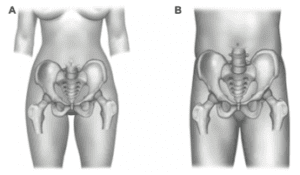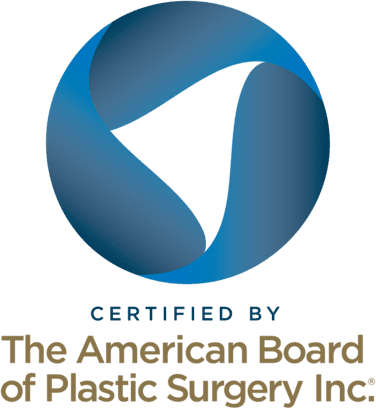Hip Dip Augmentation Surgery: Techniques, Recovery and More
Medically reviewed by Jennifer Richman on March 28, 2024.
In plastic or gender-affirming surgery, when a patient inquires about a hip dip fat transfer or hip dip implants, they are often referring to one of two things. First, a desire to fill in “hip dips,” a naturally occurring inward curve in the hip region that results from the shape of the pelvis. Second, a desire to augment the volume of the hips if they are narrower than a patient would like. Either way, a hip augmentation is designed to give the hips a wider appearance.
In the field of gender-affirming care, this procedure (hip dip augmentation), is also called hip feminization surgery, hip augmentation, and MTF hip implants. Specifically, this procedure is meant to help transgender and transfeminine non-binary patients who experience gender dysphoria due to the dimensions of their hips. For many patients, a hip augmentation can mimic the effects of having a wider pelvis from a first, estrogenic puberty.
In cosmetic plastic surgery, hip fat transfer or implants are commonly sought after by cisgender women to give the appearance of a more hourglass-shaped figure. At the Gender Confirmation Center (GCC), we only offer gender-affirming surgery to trans, non-binary, and gender variant patients. You can schedule a free, virtual, or in-person consultation for body feminization surgery here.
What Are Hip Dips and Why Do They Occur?
“Hip dips” are a naturally occurring inward curve of the hip region caused by the shape of the deeper bony structure, the pelvis. The medical term is called trochanteric depression. You may also hear it referred to as “violin hip” since the hip shape mimics the curve of the instrument. This is a common finding because hip dips can naturally be found on bodies of all shapes and sizes that developed under either estrogen- or testosterone-driven first puberty. While hip dips do not correlate to any medical differences between individuals, they can sometimes be a source of body dysmorphia for certain individuals.
Overview of Hip Dip Augmentation
In the case of many transfeminine patients, concerns about “hip dips” are often indicative of a larger concern about the width of a patient’s pelvis. An estrogen-driven first puberty often results in a widened pelvis, which widens the hips (image A). Surgically, we cannot alter the bone structure of the pelvis, but we can augment the size of the buttocks and the hips.
This is most commonly achieved by a process called fat transfer or autologous fat grafting. This involves liposuction to different parts of the body to harvest an individual’s own fat cells, processing out blood and other impurities from the fat, and then injecting the patient’s own fat into the depressed areas to enhance the contour. Most commonly, patients ask us to harvest fat from the trunk region (the abdomen, flanks and lower back). The procedure and recovery are similar to other body contouring or Brazilian Butt Lift (BBL) procedures.
Besides analogous fat grafting, patients may also opt to have silicone implants placed in the hips to augment their size. We discuss the differences between these two options in the “techniques” section of this article.
Frequently Asked Questions About Hip Dip Augmentation
Are the results of a hip fat transfer surgery permanent? Will weight fluctuations affect my results?
Six months after surgery, the results from a fat transfer for hip dips are considered permanent. During surgery, your surgeon will “over-inject” the area you desire to augment; this is because some of the fat that we inject into the hips will be reabsorbed into the body during the first six months of healing.
Please note that any weight fluctuations post-op will likely alter the results of your analogous fat transfer. If you gain or lose fat, you can expect the fat deposits in your hips to decrease or increase, respectively. For this reason, we believe that the ideal candidate for a fat grafting surgery is a patient whose lifestyle will permit them to maintain a stable weight over time. Significant weight fluctuations post-op can compromise surgical results in the long term, which is why some patients come in for touch-ups on their fat transfer surgery at around the 10-year post-op mark.
Is hip dip surgery dangerous? What are the risks and complications?
Any major plastic surgery carries risks. While pain and inflammation are normal and expected complications, if pain does not decrease with pain medications, patients should contact their surgeon right away and may need to go to an emergency room. Other possible complications include asymmetry, fat tissue necrosis, blood clots, seromas, and hematomas, which can often be prevented by carefully following recovery instructions.
Undergoing surgery with a board-certified provider who has hospital privileges can significantly decrease your risk of experiencing complications or having them worsen. Likewise, we recommend that patients quit tobacco and nicotine use and ensure that any medical conditions you have (like diabetes or high blood pressure) are being actively monitored, treated, and are optimized by your doctor.
How long is the recovery from a hip augmentation fat transfer?
Recovery from a fat grafting procedure takes up to 6 weeks. Patients should avoid putting prolonged pressure on the injected area (lying down or sitting) for the first 3 weeks to prevent pressure necrosis or tissue death of the transferred fat cells. Patients who undergo fat grafting to the hips and/or buttocks should lay on their stomachs during this time. You will also experience moderate pain, bruising, and inflammation through the first 3 weeks after surgery. Most patients will return to work around 2 weeks after their operation. Strenuous exercise and weight lifting (over 10 lbs) should be avoided for the first 6 weeks of recovery.
What’s the difference between hip dip augmentation and a Brazilian Butt Lift (BBL)?
BBLs and hip dip fat transfers are surgically very similar procedures; they involve liposuctioning fat out of unwanted areas, purifying it, and injecting it into areas that the patient would like to augment. In fact, many patients elect to undergo both procedures simultaneously if they have enough fat to augment both the buttocks and the hips.
What other procedures can be performed simultaneously with hip feminization surgery?
The procedures that can be conducted alongside a hip augmentation depends on the unique surgical plan you co-create with your surgeon in a free consultation. What we can do is determined by your goals, medical history, and financial possibilities. That said, for most patients, we can generally conduct the following procedures at the same time as hip feminization surgery:
Body contouring is usually not performed alongside facial surgery or bottom surgery to not overwhelm the body during the recovery process. That said, patients who are undergoing minimal bottom surgery or facial surgery procedures (e.g., only a tracheal shave), may be able to undergo a simultaneous hip augmentation procedure.
Will estrogen hormone replacement therapy (HRT) give me wider hips?
The pelvis is made up of several bones that begin to fuse as early as the age of 15 and finishes fusing when someone is in their 20s. Still, peer-reviewed research on gender-affirming hormone therapy (HRT) has shown that differences in pelvic width are only seen in patients who begin puberty blockers during the early stages of puberty. Adolescents that start blockers during the middle and later stages of puberty and patients who begin HRT in adulthood are very unlikely to see their pelvic geometry differ from the trends of their sex assigned at birth.
Fat redistribution on HRT can take 2-5 years of continuous, full-dosage treatment to see its maximum effect. Estrogen HRT most often redistributes fat from the stomach to the hips, glutes, breasts, and underarms for trans and non-binary individuals. These changes can significantly reduce feelings of gender dysphoria in many patients. However, some transfeminine individuals may still find it necessary to undergo hip augmentation surgery due to the potential limitations of HRT on altering the hip-to-waist ratio (HWR).
How much does hip dip augmentation cost?
For cash-pay patients, body feminization surgery can cost anywhere from $1,500-$1,900. This range is a rough estimate that varies from patient to patient and does not include facility fees, anesthesia fees, or hospital fees (if a patient has to stay overnight in the hospital).
Can insurance cover hip feminization surgery?
Insurance can significantly reduce the costs of gender-affirming body contouring for many patients. That said, coverage for gender-affirming liposuction tends to be more limited than coverage of other gender-affirming procedures. At the GCC, our insurance concierge has a 90% success rate of securing coverage for interested patients.
Although our surgeons don’t require anyone to be on hormone replacement therapy (HRT) for gender-focused body contouring or breast augmentation, being on estrogen for a year prior may have a positive effect on fat distribution, gluteal, and hip shape. Likewise, most insurance providers require that patients be on continuous estrogen HRT for at least one year prior to surgery to cover the surgery.
Techniques for Hip Dip Augmentation
Surgical Methods
-
- Fat Grafting or Fat Transfer: This procedure starts with liposuction to harvest an individual’s own subcutaneous fat cells. The fat is then processed to filter out blood and other impurities, and then injected into the hips and/or buttocks. Since this procedure is conducted with a small tube called a cannula, scarring will be minimal. Complications are rare and may include infection, pain, swelling, asymmetry, and more.
- Silicone Hip Implants: Your surgeon will create a small incision that can be concealed by undergarments and swimsuits to place silicone implants at the site of the hips. Patients can choose a custom size of silicone hip implants. Complications include infection, pain, swelling, asymmetry, visibility of the edges of the implant, and more.
- Comparing both approaches: In our practice, fat transfers are more popular because recovery is often shorter than with implants, implants can shift, implants carry a greater risk of being rejected by the body since they are a foreign body, and many patients believe that hip implants have a “less natural feel.” That said, the results of silicone implants are more immediately visible and are more likely to be permanent since fat loss will not alter the size of the implant.
Non-Surgical Options
At the GCC, we only offer surgical hip augmentation; non-surgical alternatives do not offer permanent results, nor can they be covered by insurance as medically necessary gender-affirming procedures. The following options are offered by certified nurse practitioners in cosmetic beauty practices.
- Dermal Fillers: Depending on the type of filler used–hyaluronic acid, poly-L-lactic acid, etc.–results can last from six months to two years. Fillers are injected into the site of the hip dips; due to the size of the area, multiple injections are usually needed to achieve the patient’s desired results.
Choosing the Right Practitioner for Hip Dip Augmentation
For any plastic surgery procedure, it is important to choose a surgeon who is board-certified, has hospital privileges, and is trained and experienced in the technique you are interested in undergoing. Especially for trans and non-binary patients, we recommend undergoing surgery with a provider who has experience with gender-affirming body contouring since they are more likely to be familiar with the unique anatomy of transfeminine patients. Likewise, board-certified surgeons like Dr. Ley (she/her/they), Dr. Facque (he/him), and Dr. Mosser (he/him) have extensive knowledge of what body contouring techniques are best suited to help trans, non-binary, and gender expansive folks meet their gender embodiment goals. You can request a free, virtual consultation with the GCC here.
What to Expect During the Recovery Process
Generally speaking, recovery from a fat grafting procedure takes six weeks, though it takes six months to see your final results. During the first 24 hours after surgery, we recommend that you have around-the-clock care. During the first few weeks, you will need help completing household chores to not overexert yourself.
You will wake up after surgery with a compression garment and/or compression wraps that you will need to wear 24/7 for at least three weeks after surgery. The garments and/or wraps can be removed briefly to take a shower, starting 24 hours after surgery. That said, patients must avoid bathing and submerging the surgical site underwater for at least three weeks.
Please avoid placing pressure on your hips, like lying down on your side, for at least the first three weeks after surgery to avoid fat necrosis. For more information on recovery, click here.
Resources
- GCC Webinar: the Steps to Getting Gender-Affirming Surgery
- Support Letters from a Therapist: Documentation for Insurance Coverage
- Candidacy and Weight Gain before Fat Grafting Procedures
- Feminizing Trunk Liposuction
- Abdominoplasty
- Non-Binary Body Contouring
- Breast Augmentation
Request a Free Surgical Consultation Today.
All virtual and in-person consultations with our board-certified surgeons are free. Once you fill out this form, our patient care team will reach out and guide you through every step to get to surgery.





